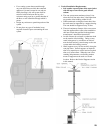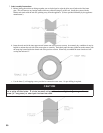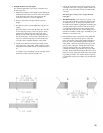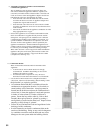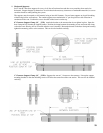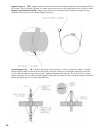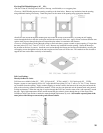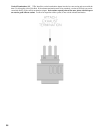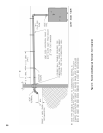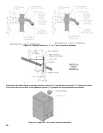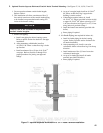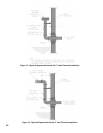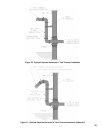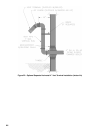37
Vertical
–
10. Installation of a vertical vent tee 8116304U is
required on all vertical vent applications. See
Figure 6. Attach vertical vent drain tee directly to
elbow or horizontal pipe from an elbow immediately
after vent connector.
11. Install fi re stops where vent passes through fl oors,
ceilings or framed walls. The fi re stop must close
the opening between the vent pipe and the structure.
Fire stop manufacturers are Air-Jet, American Metal
Products, Metal-Fab, and Simpson Dura-Vent.
12. Whenever possible install vent straight through roof.
Refer to Figure 13 if offset is necessary. Maintain
minimum clearance to combustible materials.
13.
Install Vent Terminal.
a. Size roof opening to maintain minimum
clearance from combustible materials.
b. Use appropriately designed vent fl ashing
when passing through roofs. Follow fl ashing
manufacturers’ instructions for installation
procedures. Flashing manufacturers are Air-
Jet, American Metal Products, Metal Fab, and
Simpson Dura-Vent.
c. Extend vent pipe to maintain minimum vertical
and horizontal distance of twelve (12) inches
from roof surface. Allow additional vertical
distance for expected snow accumulation.
Provide brace as required. Refer to Figure 15.
d. Vertical venting requires fl ashing and a storm
collar to prevent moisture from entering the
structure.
e. Install storm collar on vent pipe immediately
above fl ashing. Apply Dow Corning Silastic 732
RTV Sealant between vent pipe and storm collar
to provide weathertight seal.
f. Attach vent terminal.
14. Install supplied air intake terminal onto collar of the
jacket enclosure. See Figure 16.
1. Do not exceed maximum vent length. Refer to
Table 4.
Horizontal –
2. Maintain minimum ¼ inch per foot slope in
horizontal runs.
3 Recommended horizontal installation consists of
vent being sloped down away from boiler. See
Figure 12.
4. Slope horizontal runs minimum ¼ inch per foot.
Slope towards vertical vent drain tee. Position weld
seams in vent pipes, in all horizontal runs, at the top
to avoid condensate from lying on the seams.
5. Use appropriately designed thimbles when passing
through combustible walls (thimble use optional
for noncombustible walls). Insert thimble through
wall from outside. Secure outside fl ange to wall
with nails or screws, and seal with sealant material.
Install inside fl ange to inside wall, secure with nails
or screws, and seal with sealant material.
6. For noncombustible wall application when thimble
is not used, size opening such that female (bell) end
with locking band attached cannot pass through.
7. Join vent terminal to vent pipe. Locate vent
terminal between seventeen (17) inches and twenty-
nine (29) inches from wall when joined to inside
vent piping. See Figure 14.
8. Insert vent pipe through thimble/opening from
outside and join to vent system. Apply sealant
between vent pipe and opening/thimble to provide
weathertight seal.
9. Join vent terminal to 45° elbow included in kit. Join
45° elbow/terminal assembly to vent pipe. Refer
to Section C for proper procedures for joining vent
pipe and fi ttings. See Figure 3 .
H. Indoor Air Installation – See Figures 12, 13, 14, 15 and 16.



